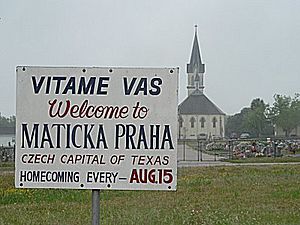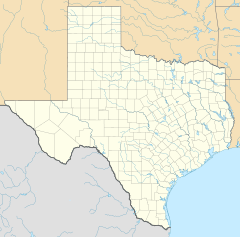Praha, Texas facts for kids
Quick facts for kids
Praha
|
|
|---|---|

Welcome sign of Praha, Texas
|
|
| Country | United States |
| State | Texas |
| County | Fayette County |
| Population
(1954)
|
|
| • Total | 21 |
Praha is a small, special place in Fayette County, Texas, in the United States. It's called an "unincorporated community," which means it's a small town without its own local government, but it's still a community.
People sometimes called it "Maticka Praha." This is a Czech phrase that means "Mother Prague." Because of its history, Praha is sometimes known as the "Czech capital of Texas."
Contents
History
Praha has a long and interesting history. It started as a small settlement and grew into a place important to Czech culture in Texas.
Early Days of Praha
The very first settlers who came to this area were James C. Duff, William Criswell, and Leroy Criswell. They were Anglo settlers. They first named the community Mulberry. It was also known by another name, Hottentot, which might have been a nickname for some local groups.
Czech Settlers Arrive
In 1854, a man named Matiáš (Matej) Novák moved to the area. He was a recent immigrant from Czechia. He bought about 100 acres (0.4 km²) of land. He built a house where early religious services, called Masses, were held.
Other Czech immigrants heard about Novák and came to settle there too. Some of these early families included Jan Baca, Josef Vyvjala, Ondřej Gallia, Josef Hájek, František Václ, and George Morýsek. In 1858, the town's name was changed to "Praha." This is the original Czech name for their capital city, Prague.
Growing and Changing
Over the next few decades, Praha slowly became a bigger town. In 1865, a priest named Joseph Bithowski built a small wooden church. The very first Mass was held there at midnight on Christmas Day.
By 1868, a public school was started for the children. In the 1880s, Praha had three stores and a restaurant. A new, larger wooden church was built, which became the main church for many towns nearby. A post office opened in 1884. In 1896, a Czech Catholic school was also established.
A Shift in Fortune
Praha started to become smaller after 1873. This happened because the Southern Pacific Railroad built its tracks about a mile north of the town. A new town called Flatonia grew up closer to the railroad tracks. Businesses and people started moving to Flatonia, away from Praha.
At its busiest time in the 1880s, Praha had about 700 people living there. But during the 1900s, the population never went above 100. The post office closed in 1906. By 1968, only about 25 people lived in Praha. In 1973, both the church school and the public school closed down.
A Special Church and Festival
Even though the town became smaller, people still come to the main church. This church is called St. Mary's Church of the Assumption. It is the most famous building in Praha today. It's a beautiful church built in the Gothic Revival style, finished in 1892.
This church is the center of a big yearly event. It's called the Feast of the Assumption homecoming festival. People have celebrated it in Praha every August 15 since 1855. Locals call it the "Praha Picnic." As many as 5,000 visitors come to enjoy traditional Czech polka music and eat delicious kolaches.
Remembering the Past
During the Second World War, Praha faced a sad challenge. It had the highest number of war deaths compared to its small population in the U.S. Many soldiers from Praha lost their lives in 1944, with nine deaths that year. To remember these brave soldiers, three small, identical chapels were built in their memory.


